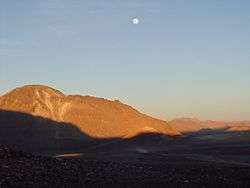University of Tokyo Atacama Observatory
The University of Tokyo Atacama Observatory (TAO) is an astronomical observatory located on the summit of Cerro Chajnantor, at an altitude of 5,640 m (18,500 ft) within a lava dome in the Atacama Desert of northern Chile.[1] The site is located less than 5 km (3.1 mi) north-northeast of the Llano de Chajnantor Observatory, where the Atacama Large Millimeter Array (ALMA) is located, but is over 580 m (1,900 ft) higher in elevation.
 Looking east towards Cerro Chajnantor, site of TAO | |||||
| Organization | University of Tokyo | ||||
|---|---|---|---|---|---|
| Location | Cerro Chajnantor, Atacama Desert, Chile | ||||
| Coordinates | 22°59′12″S 67°44′32″W | ||||
| Altitude | 5,640 m (18,500 ft) | ||||
| Established | 2009 | ||||
| Website | http://www.ioa.s.u-tokyo.ac.jp/TAO/ (English translation) | ||||
| Telescopes | |||||
| |||||
 Location of University of Tokyo Atacama Observatory (TAO) | |||||
The eventual goal of the project is to construct the TAO telescope (or TAO 6.5m telescope), a 6.5 m (260 in) optical-infrared telescope at the site.[2] A first step towards that goal has been the construction and installation of a 1.0 m (39 in) pilot telescope, called miniTAO, completed in 2009. With first light achieved in March 2009 in the visible region, and in June 2009 for the infrared region, the observatory has become the highest permanent astronomical observatory in the world. The high altitude of the observatory is essential for its mission, for it is an infrared light observatory, and infrared light is absorbed by the water vapor in the atmosphere making it imperative that an infrared observatory is located in high altitude where the atmosphere is sparse.
Description
The telescope's primary mirror will have a diameter of 6.5 m (260 in) and will be silver-coated. The secondary mirror will be equipped with adaptive optics to compensate for atmospheric turbulence. A third mirror will allow switching between several instruments. There will be a Cassegrain focus for the mid-infrared range, a Nasmyth focus for the near-infrared range and another Nasmyth focus for far-infrared.
The project started with site studies in the late 1990s and early 2000s. Road construction to the summit of Cerro Chajnantor started in November 2005. Road was opened April 2006. The miniTAO pilot telescope was constructed in 2009. The construction of the TAO telescope started in 2013.[3]
The telescope will have two primary instruments, the MIMIZUKU mid-infrared imager and spectrograph, and SWIMS near-infrared spectrograph. Both instruments were tested at the Subaru telescope and achieved first light in the summer of 2018. After testing, the instruments are to be installed into the TAO telescope.
In January 2018, the TAO telescope mount construction was completed and the telescope mount assembled in Japan. This was done for testing purposes; the telescope will be disassembled and shipped to Chile at a later date.[4]
Ground-breaking ceremonies at the site were held at late 2017.[5]
References
- Yoshii, Yuzuru; et al. (Aug 11, 2009). "The 1m telescope at the Atacama Observatory has Started Scientific Operation, detecting the hydrogen emission line from the Galactic Center in the Infrared Light". Press Release. School of Science, the University of Tokyo. Retrieved 21 December 2009.
- "TAO Project" (PDF). Comisión Nacional de Investigación Científica y Tecnológica - CONICYT. Archived from the original (PDF) on 16 July 2011. Retrieved 21 December 2009.
- http://www.ioa.s.u-tokyo.ac.jp/TAO/en/news/20130703/index.html
- http://www.ioa.s.u-tokyo.ac.jp/TAO/en/news/20180128/index.html
- http://www.ioa.s.u-tokyo.ac.jp/TAO/en/news/20171220/index.html
External links
- The University of Tokyo Atacama Observatory Project (English translation) includes numerous photos of observatory construction